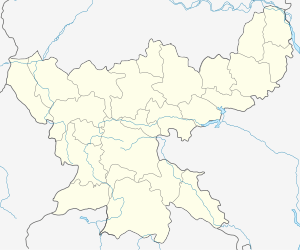Basukinath
Basukinath is a city and a notified area in Dumka district in the Indian state of Jharkhand.
Basukinath | |
|---|---|
city | |
 Basukinath Location in Jharkhand, India  Basukinath Basukinath (India) | |
| Coordinates: 24.39°N 87.08°E | |
| Country | |
| State | Jharkhand |
| District | Dumka |
| Languages | |
| • Official | Hindi, Santali |
| Time zone | UTC+5:30 (IST) |
| Vehicle registration | JH |
Location
Basukinath is located in Dumka District of Jharkhand. It lies on the Deoghar – Dumka state highway and is around 25 km northwest of Dumka. It is a place of pilgrimage for Hindus. Basukinath Temple is the main attraction here.It is situated on Jasidih Dumka New Railway line and Basukinath Railway Station is the nearest railheads. Ranchi Airport is the nearest airport. It is situated at Jarmundi Block on Dumka Deoghar State Highway at a distance of 24 km from the District Headquarters Dumka. In a year lacs and lacs people from different parts of country come here to worship Lord Shiva. In the month of Shravan people of several country also come here to worship Lord Shiva.It was the part under handwa state before independence of india whose last queen was rani Sonabati,it is written on plate on the top of the gate passes from temple to sacred pond (shivganga).There is a well inside sacred pond and shiv ling (sacred shiv stone ) is present which can be clearly seen during cleaning of pond in every few year.something is still unknown about the secret well inside pond about its origin,there is some inscription on stone inside well but it is in the form of ruined. For more details, kindly follow :http://www.bababasukinath.com [1]
Demographics
As of the 2001 Indian census,[2] Basukinath had a population of 14,119, males constituting 52% of the population and females 48%. Basukinath has an average literacy rate of 54%, lower than the national average of 59.5%; with 62% of the males and 38% of females literate. 17% of the population is under 6 years of age.
Religion
Basukinath serves as a place of pilgrimage for Hindus.[3] The Basukinath Temple is a popular attraction.[3]

Shravan Mela

Basukinath is famous for the mela of Shraavana (a month of the Hindu calendar), between July and August. Many devotees visit the place from various parts of India and offer holy water of Ganges to the deity collected from Sultangunj, Bhagalpur district in Bihar, which is almost 135 km from Basukinath. An unbroken line of people in saffron-dyed clothes stretches over the path between Bhagalpur and Basukinath is seen during the fair. Whether Some pilgrims are called "Bol Bam" they put the holy water on the shivling after 4–5 days journey. They can stop many places during the journey. While some pilgrims which are called Dak Bam and they do not stop even once in their journey from Bhagalpur to Basukinath. The pilgrims to Basukinath later visit the Baidyanath Jyotirlinga in Deogarh.[4]
Ram Janki Vivah Utsav
Vivah Panchami is a Hindu festival celebrating the marriage of Ram and Sita. It is observed on the fifth day of the Shukla paksha or waxing phase of moon in the Margashirsha month (November – December) as per Hindu calendar. The day is observed as the Vivah Utsav of Sita and Rama in temples and sacred places associated with Sri Rama. Late Pandit Nainalal Jha, Pradhan Tirth Purohit Baba Basukinath, started the festival of "Ram Janki Vivah Utsav" in Basukinath. He used to celebrate this festival with lot of enthusiasm. A baraat which included elephants and horses participated in the procession. He used to call it "Palki Utsav". Prenently it is taken forward by his son Pandit Tara Kant Jha.
References
- The official website bababasukinath.com
- "Census of India 2001: Data from the 2001 Census, including cities, villages and towns (Provisional)". Census Commission of India. Archived from the original on 16 June 2004. Retrieved 1 November 2008.
- "Basukinath is located in Dumka District of Jharkhand". Archived from the original on 7 October 2007. Retrieved 1 August 2007.
- "Month-long Shrawani Mela ends". The Times of India. 6 August 2009. Retrieved 6 April 2010.